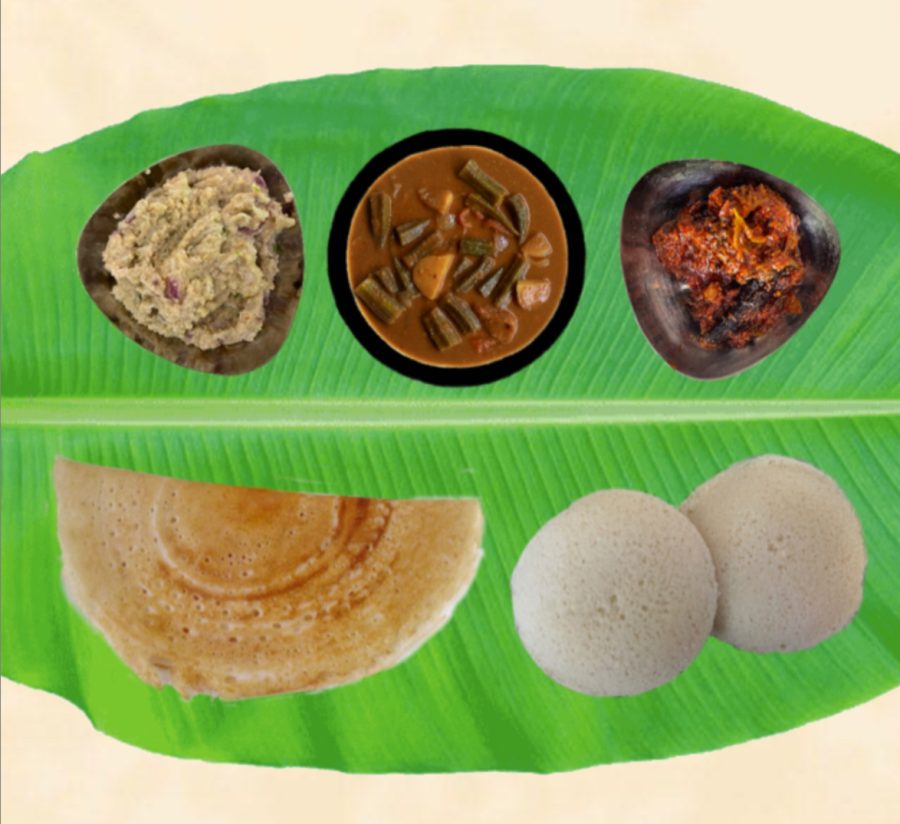My favorite South Indian breakfast: The Andhra tiffin
Graphic Illustration by Shamita Gurusu
My family’s Andhra tiffin, a dish prominent in my childhood days, is simply irresistible. It is a breakfast platter traditionally served on a large banana leaf with a crispy crepe called dosa, thick rice cakes called idli, a spicy bottle gourd soup called sambar, any chutney and a spicy pickle of your choice.
April 21, 2021
My family’s Andhra tiffin, a dish prominent in my childhood days, is simply irresistible. It is a breakfast platter traditionally served on a large banana leaf with a crispy crepe called dosa, thick rice cakes called idli, a spicy bottle gourd soup called sambar, any chutney and a spicy pickle of your choice. With its vibrant colors of red, green, tan and golden as well as its mix of tangy, sweet and spicy, this dish is quite inviting.
The meaning of the word tiffin varies across India; in my Andhra household, we simply call our first big meal of the day a tiffin. To my ancestors, breakfast was the most important meal, as they would usually be out in the fields all day and need copious amounts of energy. Tiffin incorporates all key spices and grains that the state of Andhra Pradesh produces: rice, coconut, okra, bottle gourd, mint, coriander, chiles, mustard seeds and mango. Because it uses local ingredients, the Andhra tiffin became the cheapest and most convenient breakfast for any individual with a labor-intensive job.
In my household, my mom has always made the idli and dosa batters on the weekend. She would start the process on Saturday morning by soaking a basin of short grain rice and a basin of semolina in a 3:1 ratio. After the rice had soaked for at least 12 hours, she would then remove the water from the basin and use the wet grinder to create two thick and runny batters. The idli and dosa batters would then ferment overnight and be ready to use by Sunday morning. To cook the idli, we use an idli steamer which has preset molds for the idli batter to be poured into and then cooked in for 20 minutes. To cook the dosa, we use a flat pan, grease it with oil, spread a thin layer of the dosa batter all over the pan and fry it until golden and crispy.
My mom would also make a large pot of sambar and chutney on Sunday to last the whole week. To make sambar, she would first fry bay leaf, onions, garlic, ginger, chillies, tomato, cumin and split Bengal gram. Then, she would toss in cubed bottle gourd, some eggplant and okra if we had any, and an entire pot of water. After boiling for 30 to 34 minutes, the sambar was done. As for the chutney, my mom made many variations: mint, coconut, peanut, green chilli, tomato and bell pepper; the most common being the peanut chutney. She would start by roasting peanuts, green chilis and cumin. Then, after the mixture had cooled, she would toss them into the blender and the chutney was done.
My parents would cook the entire family this tiffin together and would serve the dosas and idlis with some sort of combination of chutney, sambar and store bought pickle. The tiffin was nutritious, filling and tasty. This was the only part of the morning when our entire family spent time together, and this meal became important to all of us.
Since I ate this so much as a child, I thought it had lost its appeal to me and it was simply a phase in my past. However, after eating the Andhra tiffin last year, when my parents decided to make it for the first time in three years, I felt a rush of nostalgia. I realized that the memories this dish holds are what makes it such a special food for me.
To continue making cherished memories with my family and to respect the long way the Andhra tiffin has brought my family and my ancestors, I try to make this dish at least once a month. Despite it being a lengthy and tedious process, the Andhra tiffin is a meal that does the best at bringing my family together. This wholesome and nutritious meal is worth it.




























































